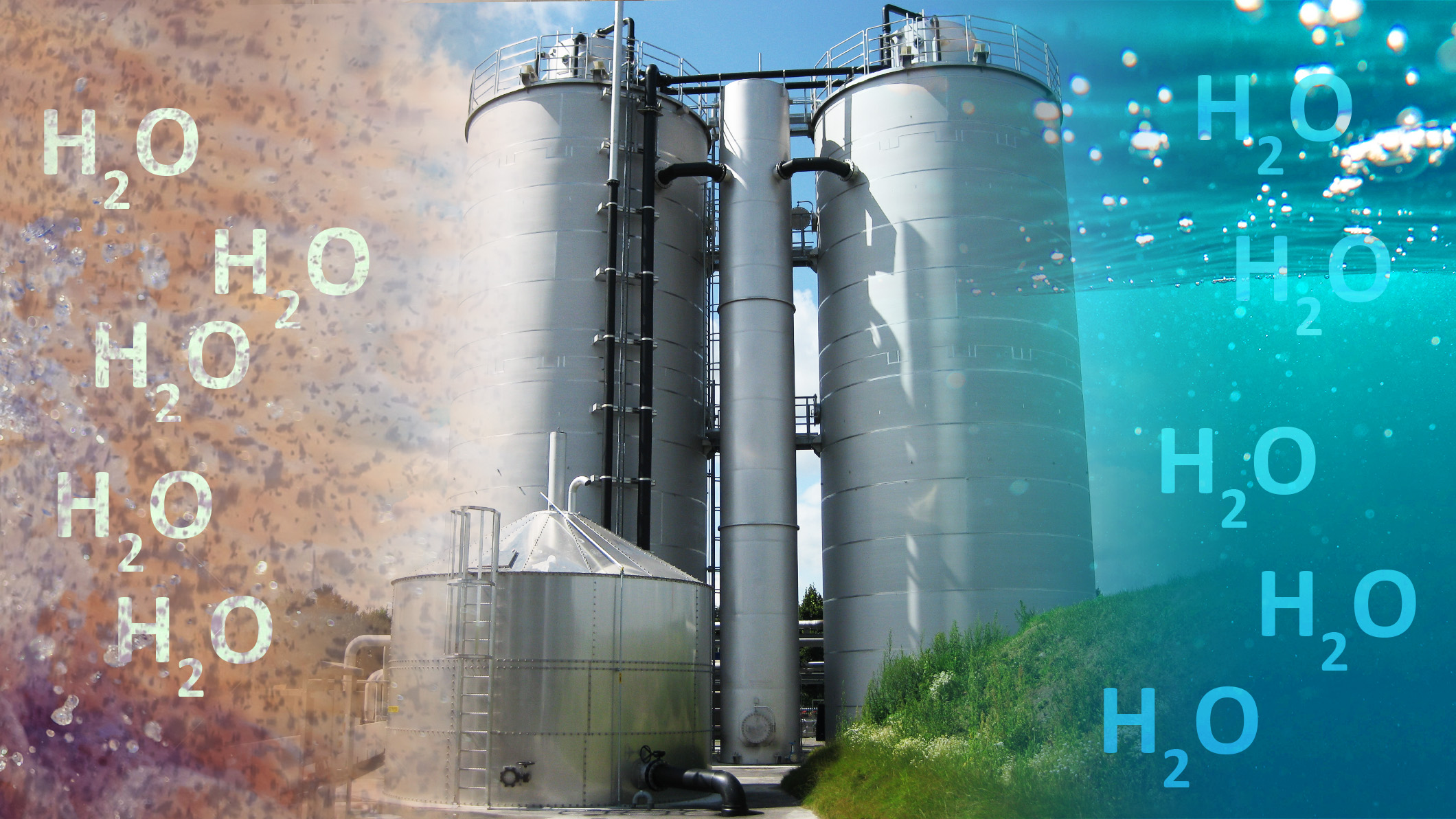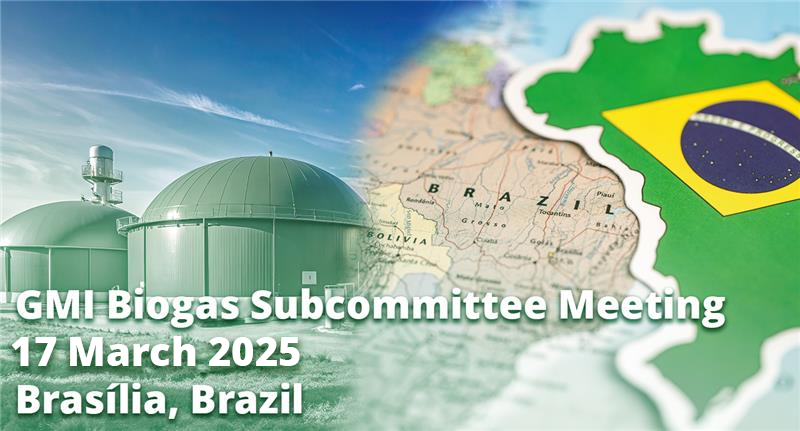Methane Mitigation: Lessons Learned from India’s Compressed Biogas Projects
India's CBG projects: methane mitigation through biogas conversion.
GMI Financial Readiness Framework for Organic Waste Management
This resource helps governments and developers secure financing, mitigate risks, and improve the viability of organic waste projects.
Waste Characterization Handbook:
Understanding Municipal Waste Streams to Develop Data-Driven Methane Mitigation Strategies
GMI Policymaker Framework for Addressing Methane Emissions
A step-by-step process and resources for policy development
How India’s Cleanest City Reduces Methane Emissions from Municipal Solid Waste
Case Study
Measurement, Reporting and Verification (MRV) Resource Center
A resource center providing information and tools to support the MRV of methane emissions and emissions reductions.
Biogas Sector
The GMI Biogas Subcommittee focuses on building capacity within Partner Countries to leverage common interests across the areas of agriculture, municipal solid waste, and municipal wastewater. These interests include biogas energy use, the types of wastes managed, waste treatment technologies, and the potential for synergistic projects involving input streams from multiple sources. Efforts include developing and promoting tools, policy guidance, and project development resources at the national, state, and city level within Partner Countries.
GMI Technical Groups
Within the Biogas Sector, GMI maintains active technical groups in the areas of agriculture, municipal solid waste (MSW), and municipal wastewater. These groups provide international leadership to mitigate global methane emissions through the abatement, recovery, and use of methane. They promote collaboration between delegates from Partner Countries and Project Network members to build capacity, develop strategies, and expand opportunities for using methane as a renewable energy resource.

Agriculture
Methane emissions come from livestock enteric fermentation, livestock waste management, rice cultivation, and agricultural waste burning.

Municipal Solid Waste
Municipal solid waste management and treatment activities such as landfilling and anaerobic digestion are sources of methane emissions worldwide.

Municipal Wastewater
Methane is produced when the organic material in municipal wastewater decomposes anaerobically.
Recent Resources
For a complete list of available biogas resources, including technical documents, presentations, and tools, please visit the resources page.

Methane Mitigation: Lessons Learned from India’s Compressed Biogas Projects (2025)
The U.S. EPA, in collaboration with The Energy and Resources Institute (TERI) of India, released an analysis entitled, “Methane Mitigation: Lessons Learned from India’s Compressed Biogas Projects.” This report assesses facilities that mitigate methane emissions by generating compressed natural gas (CNG) from biogas feedstocks, such as livestock manure and agriculture waste, utilizing anaerobic digesters, in India. The report summarizes the developmental and operational challenges for such “Compressed BioGas (CBG)” plants, specifically focusing on the challenges and opportunities that stakeholders face in the development and operation of CBG plants. Recovering methane from agriculture and food waste and converting it to energy resources is critical to methane mitigation efforts in India and energy security in developing countries.

Training Series: Best Practices for Landfill and Organic Waste Management (2024)
In 2024, the U.S. EPA, in collaboration with the Asian Development Bank and in support of the Global Methane Initiative (GMI) Biogas Subcommittee, hosted a four-part training series: Best Practices on Landfill and Organic Waste Management. The training focused on proven approaches and case studies for dumpsite closure and remediation; sanitary landfill construction, operation, and maintenance; organic waste treatment; feedstock management; greenhouse gas (GHG) measurement, reporting, and verification; and useful tools and resources. The training was initially delivered to implementers of the Bahawalpur Integrated Solid Waste Management project in Pakistan, but the training materials are broadly applicable to national and subnational decision-makers and policymakers, waste professionals, waste facility operators, and project developers.
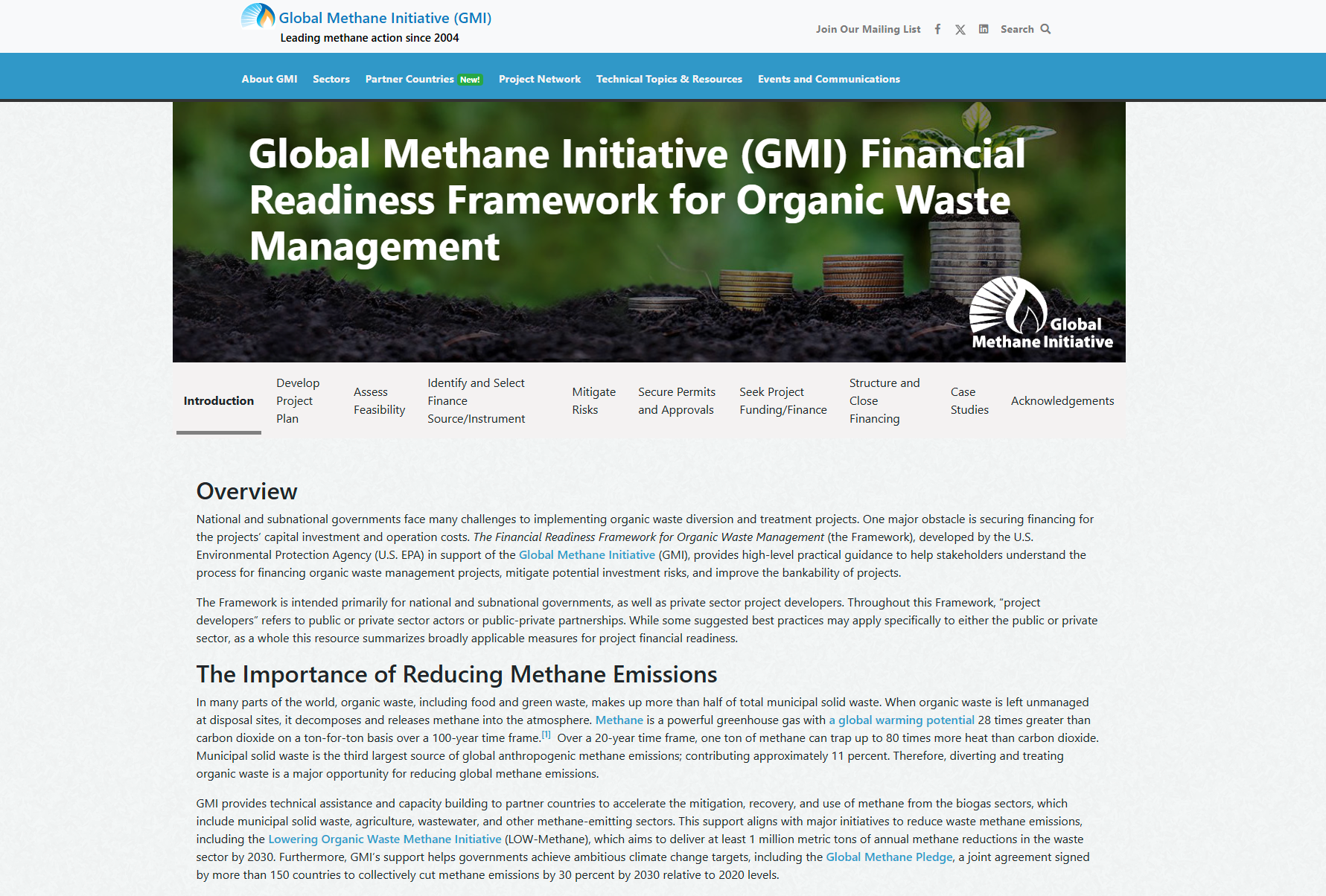
Financial Readiness Framework for Organic Waste Management (2024)
This resource provides high-level step-by-step practical guidance to help stakeholders understand the process for financing organic waste management projects, mitigate potential investment risks, and improve the bankability of projects.
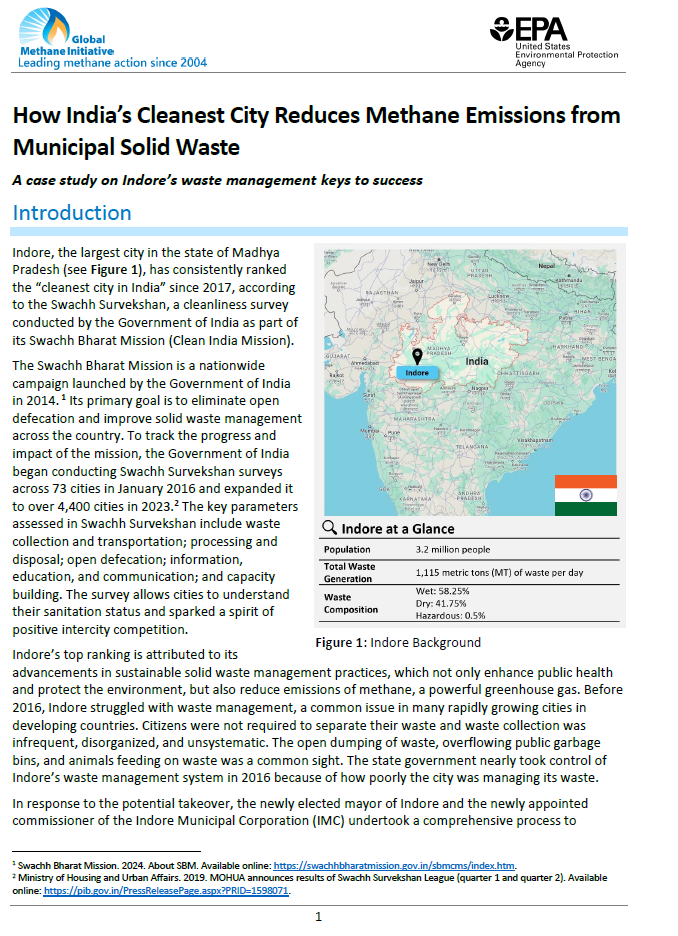
How India’s Cleanest City Reduces Methane Emissions from Municipal Solid Waste (2024)
This case study provides an overview of the factors that contributed to the successful transformation of Indore’s waste management system, including leadership buy-in, public engagement and participation, pilot testing, infrastructure upgrades, and innovative financing. It can serve as a model for cities around the world to improve solid waste management and reduce methane emissions and other climate pollutants.

Methane Mitigation from Municipal Wastewater Treatment Plants (2023)
This fact sheet provides an overview of methane emissions generated in both wastewater collection systems and at wastewater treatment plants (WWTP). Topics include wastewater collection systems, conventional activated sludge (CAS) treatment systems, aerobic/aerated lagoon treatment systems, and anaerobic lagoon treatment systems. Biosolids management and opportunities for methane mitigation and use are also described.

Establishing Biogas-Powered Cold Storage in Rural India for Methane Mitigation and Sustainable Food Systems (2023)
Mitigating post-harvest food loss can result in economic benefits for farmers, increase food security, and reduce methane emissions from organic waste. An estimated 30 percent of food produced in India is lost or wasted, despite the country ranking 94th out of 100 on the 2020 Global Hunger Index (Bagai, 2020). Almost half of post-harvest food losses in India are attributed to the lack of a reliable cold chain, the integrated network of refrigerated storage facilities, transportation, and merchandising technologies that maintain food quality moving from harvest to the consumer (Peters et al., 2019). Cold-chain technologies are energy intensive and typically powered by fossil fuels. In recent years, there has been a focus on clean energy powered cold-chain solutions, including renewable energy powered cold storage facilities that store commodities immediately after harvest.

Biogas and Gasification Matchmaking Platform (2022)
The Biogas and Gasification Matchmaking Platform facilitates networking among international providers and users of biogas and bio-methane technologies. Developed by the Digital Global Biogas Cooperation (DiBiCoo), the online platform acts as a database of biogas and gasification related stakeholders.

Policy Maker’s Handbook for Measurement, Reporting, and Verification in the Biogas Sector (2022)
The Policy Maker’s Handbook for Measurement, Reporting, and Verification in the Biogas Sector can help government decision-makers overcome barriers in accounting for emissions and emissions reductions from biogas projects. The handbook serves as a high-level resource, intended primarily for national governments, on how applying best practices for project-level Measurement, Reporting, and Verification (MRV) in the biogas sector can support national-level objectives.

Market Opportunities for Anaerobic Digestion of Livestock and Agro-Industrial Wastes in India (2020)
The report on the Market Opportunities for Anaerobic Digestion of Livestock and Agro-Industrial Wastes in India will help inform project developers, policymakers, and other interested stakeholders about the potential for biogas capture and use in India. The report estimates biogas production and emission reduction potential from India’s largest agricultural sectors, and it includes an overview of the uses of biogas and digestate, current biogas policies, technology options, and business models relevant for India.

Naucalpan, Mexico Waste Characterization Study (2019)
In March 2017, the U.S. Environmental Protection Agency – as a lead partner in the Waste Initiative – conducted a waste characterization study at the municipality’s transfer station. The study indicated that approximately 69% of the waste handled at the transfer station could be recycled or otherwise diverted from the landfill, and that more than half of the waste could be used as feedstock in composting or anaerobic digestion projects. The municipality is using the results of the study to inform decision making about the project design and procurement options.
Featured Tools
Check out these featured tools.

Waste Characterization Handbook and Tool (2024)
The Waste Characterization Handbook and accompanying Excel tool helps cities, communities, and other waste stakeholders plan and conduct waste characterization studies. The resulting data can be used to evaluate existing projects, develop new waste management strategies, and assess their solid waste management options. Waste characterization data can be input into existing GMI resources, including the Solid Waste Emissions Estimation Tool (SWEET), Anaerobic Digestion Screening Tool, and Landfill Gas Screening Tool.

Solid Waste Emissions Estimation Tool (SWEET) (2022)
SWEET is a free Excel tool created by the Waste Initiative. SWEET helps users scope emissions sources such as waste collection and transportation, open burning, landfill gas collection systems, organic waste management projects, waste handling equipment (e.g., bulldozers), and waste incineration facilities. It estimates waste sector emissions including methane, black carbon, and several other pollutants. It also evaluates emissions reduction benefits of multiple alternative waste management scenarios.

Anaerobic Digestion Screening Tool, Version 2.4
The U.S. Environmental Protection Agency, on behalf of the Global Methane Initiative (GMI), developed the Anaerobic Digestion (AD) Screening Tool to assist stakeholders in assessing the potential feasibility of an AD project.
The AD Screening Tool enables users to conduct pre-feasibility analyses to evaluate AD opportunities for a variety of feedstocks, including organic municipal solid waste, livestock manure, agricultural residues, and wastewater. The tool generates the following outputs:
- Annual biogas and digestate production
- Project methane emission reductions
- Potential end uses of biogas, including estimates for electricity production, natural gas production, cooking gas potential, and home heating potential
This tool is intended to help project developers, government agencies, financial institutions, and other stakeholders conduct an initial screening assessment of the technical and financial feasibility of proposed AD projects.

Landfill Gas Screening Tool (LFG-ST) (2021)
The Landfill Gas Screening Tool’s goal is to assist cities in assessing the potential feasibility of a landfill gas energy (LFGE) project. It provides a preliminary estimate of how much landfill gas (LFG) a site could collect, and whether that fuel supply is likely sufficient to support a modest-sized LFGE project. LFGE project types include combusting LFG directly to produce heat (e.g., for industrial applications), using LFG to generate electricity, and - in some cases - converting LFG into a compressed natural gas (CNG) to fuel vehicles.

Biogas Toolkit (U.S. EPA) (2020)
The U.S. Environmental Protection Agency (EPA) Biogas Toolkit serves as a centralized knowledge hub for biogas project stakeholders. The toolkit is designed to allow stakeholders to search and browse for information and resources that meet their specific project needs. The toolkit includes information and resources compiled from across several EPA programs, including AgSTAR, the Landfill Methane Outreach Program (LMOP), and GMI.

OrganEcs Version 3.1
OrganEcs is a tool for estimating the costs associated with an organic waste management project. It provides planning-level assistance to local governments, waste professionals, policymakers, facility operators, and project developers to help them make financial decisions about their potential organic waste management projects.

Biogas Wastewater Assessment Technology Tool (BioWATT) (2016)
The Biogas Wastewater Assessment Technology Tool (BioWATT) provides a quick and preliminary assessment of wastewater-to-energy projects. Through BioWATT, users can receive a specific summary of their biogas production estimates for various wastewater-to-energy technologies, electricity generation potential from the produced biogas, greenhouse gas savings associated with biogas-generated electricity, and more.

International Best Practices Guide for Landfill Gas Energy Projects (2012)
Global Methane Initiative’s (GMI) International Best Practices Guide for Landfill Gas Energy Projects provides a broad overview of the development process for LFGE projects in international settings and presents the technological, economic and political considerations that typically affect the success of LFGE projects. The goal of the guide is to encourage environmentally and economically sound LFGE projects by connecting stakeholders with available information, tools and services. The guide is not intended to provide a step-by-step protocol for project development.

Central and Eastern Europe Landfill Gas Model
The Model can be used to estimate landfill gas generation rates from SWD sites, and potential landfill gas recovery rates for disposal sites that have, or plan to have, gas collection and control systems and are located in Central or Eastern European countries. The Model also may be used for SWD sites in other countries which experience similar site conditions and climate, and have waste composition data.

Colombia Landfill Gas Model
The Model can be used to estimate landfill gas generation rates from landfills, and potential landfill gas recovery rates for landfills that have, or plan to have, gas collection and control systems in Colombia.
Spanish Version: Colombia Landfill Gas Model and User Manual
Upcoming Events
High-Rate Anaerobic Wastewater Treatment Training Course
22 January–7 March 2025, Virtual
Anaerobic wastewater treatment is one of the most energy-efficient technologies for treating wastewater. With minimal energy requirements and the conversion of organic pollutants into renewable energy-rich biogas, there’s a double energy gain – a serious benefit both for now and in the future.
In this course, organized by the International Water Association (IWA) and Delft University of Technology, participants will learn about this state-of-the-art technology from anaerobic experts. Participants will also develop skills in anaerobic reactor design and operation to better handle the current environmental challenges and global energy crisis.
After taking this course, participants will not only understand the potentials of the system but also how to make process designs, evaluate anaerobic treatment processes, and operate high-rate anaerobic reactors efficiently.
By the end of this course participants will be able to:
- Explain the concepts and advantages of high-rate anaerobic treatment
- Make a mass balance over you anaerobic reactor and calculate the methane production potential based on the residual water characteristics
- Recognize the key factors affecting high-rate anaerobic treatment
- Identify the development and the key features of high-rate anaerobic reactors, and identify the challenges and potentials for a specific high-rate anaerobic technology
- Acquire the ability to design upflow anaerobic sludge blanket (UASB) reactors under specific conditions, and identify the procedures needed to start-up UASB reactors with low grade seed material
- Identify the most important anaerobic laboratory tests, acquire the theoretical knowledge to assess the maximum capacity of anaerobic sludge, and the biomethane or toxicity potential of waste(waters)
- Recognize the current application of high-rate anaerobic treatment technologies in practice
The course is ideal for students, academics, consultants, and practitioners in the field of environmental engineering and/or sanitary engineering. It will deepen your knowledge of anaerobic wastewater treatment and provide valuable background information for anybody interested in the field. Participants from developing countries and countries in transition are especially welcome, as this is the right moment to acquaint yourselves with and choose more sustainable solutions in waste and wastewater management, establishing your own energy factory. Since energy benefits may amount to several million euros per year, end-users working in the food and beverage industry, chemical companies, pulp and paper mills, etc., can also benefit from the course.
Upon completion of the course, participants will receive a professional certificate and are eligible to receive 3.0 Continuing Education Units. The course fee is 995 EUR for general participants, and 895.5 EUR for IWA members.
The course will start on 22 January 2025 and end on 7 March 2025, and will consist of 4-5 hours per week.
Climate & Clean Air Conference 2025
16–21 March 2025, Brasilia, Brazil
The Climate & Clean Air Conference 2025 is set to take place from March 16–21 2025, in Brasilia, Brazil. This year’s theme, “Preparing for COP30: Tackling Super Pollutants to Avoid the Catastrophic Overshoot of 1.5°C,” highlights the urgent need for decisive action. The event will bring together country representatives, global experts, and changemakers, united with over 180 partners, to drive accelerated solutions for mitigating super pollutants and safeguarding our planet’s future. The GMI Biogas Subcommittee meeting will be held on 17 March in conjunction with this meeting.
GMI Biogas Subcommittee Meeting
17 March 2025, Brasilia, Brazil
The GMI Biogas Subcommittee meeting will be held in person on Monday, 17 March 2025 in Brasilia, Brazil in conjunction with the Climate & Clean Air Conference 2025.
- Offer regional discussions
- Provide resource sharing opportunities
- Facilitate open discussions
- Feature a discussion about the GMI Biogas Subcommittee Sprint Action Plan
Biofuels Expo 2025
25–26 September 2025, Vienna, Austria
Biogas Subcommittee
Subcommittee Co-chairs
Patrick CoatarPeter, Co-Chair
U.S. Environmental Protection Agency (EPA)
United States
Godfred Fiifi Boadi, Co-Chair
Ministry of Sanitation and Water Resources
Ghana
Matt Hamilton, Co-Chair
Environment and Climate Change Canada (ECCC)
Canada
Subcommittee Members
Representatives from 29 countries participate in the Biogas Subcommittee.
Project Network
Hundreds of Project Network members support methane abatement projects in the biogas sector.
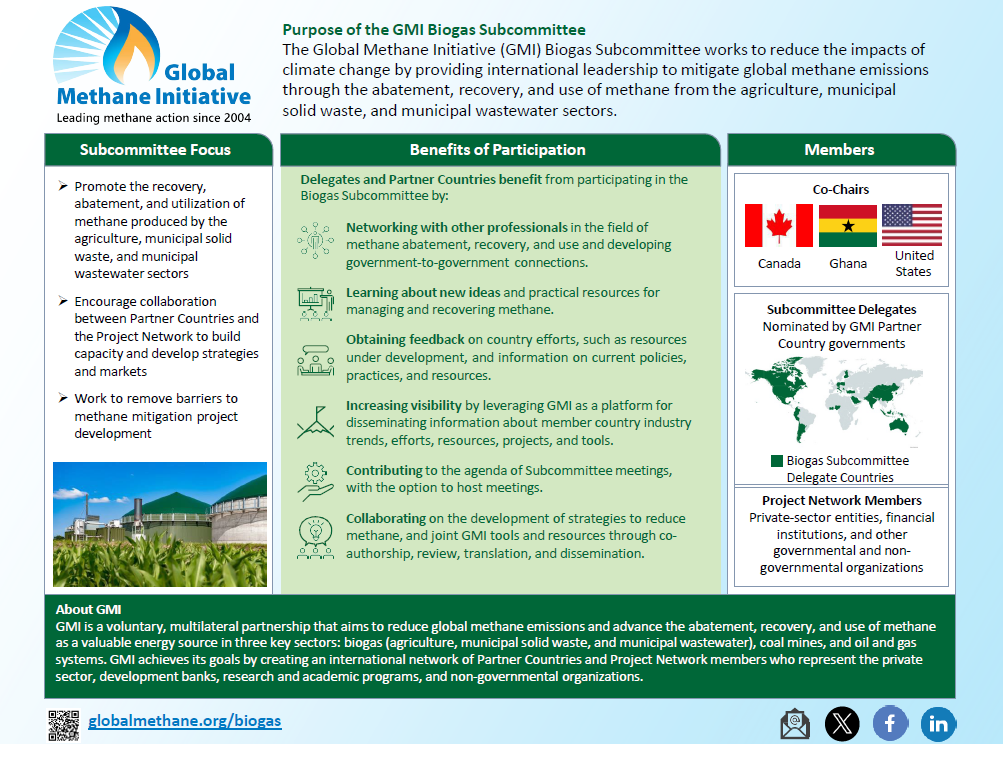
Biogas Subcommittee Statement of Purpose
Connect, Contribute, and Stay in Touch
Are you actively involved in methane mitigation projects in the biogas sector?
Use the contact us form to let us know about your expertise and how you would like to get involved with GMI.
Would you like to recommend a resource?
Click the button below to recommend a resource that you would like to see featured on the GMI website. The Secretariat and members of the Biogas Subcommittee will review your recommendation.
Would you like to receive updates?
Sign up on the GMI mailing list to receive communications from GMI by email. You can select your topics of interest.
Global Methane Initiative (GMI)
Leading methane action since 2004
